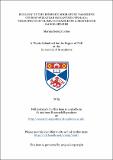Files in this item
Ecology of the endemic migratory passerine Cyprus wheatear Oenanthe cypriaca : the effects of climate change on a restricted range species
Item metadata
| dc.contributor.advisor | Cresswell, Will | |
| dc.contributor.author | Xenophontos, Marina | |
| dc.coverage.spatial | vi, 255 p. | en_US |
| dc.date.accessioned | 2017-10-31T14:55:04Z | |
| dc.date.available | 2017-10-31T14:55:04Z | |
| dc.date.issued | 2015-03 | |
| dc.identifier.uri | https://hdl.handle.net/10023/11967 | |
| dc.description.abstract | Migrant birds may be vulnerable to climate change at different stages of their annual cycles especially on the breeding grounds, where changes in phenology may affect their ability to synchronise breeding with the peak of resources availability. Understanding how phenology of breeding, survival and productivity varies between and within years is therefore crucial to understand migrant population dynamics. This thesis describes this variation in the Cyprus Wheatear Oenanthe cypriaca, with particular emphasis on a colour-ringed population at Troodos, Cyprus, 2010 - 2012. Our results suggest that the phenology of breeding of Cyprus Wheatear is variable with breeding onset and number of breeding attempts probably varying with annual temperature variation. Minimum true survival rates were very high for a small passerine migrant, although they were probably sufficiently annually variable to profoundly affect annual population dynamics. For productivity, nest survival was very high and did not vary between years, or nesting attempts, or with clutch initiation date but it was significantly higher in the chick stage versus the egg stage. Post-fledging survival in the first 4 weeks was very high. Renesting probability was significantly different in all years, yet total productivity per pair was the same in each of three years. Cyprus Wheatears at Troodos showed such high productivity and survival that the population must be a major source population and this was reflected in the very high density of breeding pairs at the study site. Finally we used altitude as a proxy for variation in temperature and investigated how abundance, productivity and phenology in Cyprus Wheatears varied between and within years, from sea level to 1952m, using transect surveys to record breeding birds across Cyprus. Cyprus Wheatears were common in all habitats and altitudes; altitudinal temperature variation probably affected the occurrence of double brooding and so the timing of chick production, but not the onset of breeding. The results suggest that Cyprus Wheatears are already very well adapted to high variation in temperature within and between seasons, changing investment accordingly. | en_US |
| dc.language.iso | en | en_US |
| dc.publisher | University of St Andrews | |
| dc.subject.lcc | QL696.P288X4 | |
| dc.subject.lcsh | Wheatears--Cyprus | en |
| dc.subject.lcsh | Climatic changes--Cyprus | en |
| dc.subject.lcsh | Birds--Reproduction | en |
| dc.title | Ecology of the endemic migratory passerine Cyprus wheatear Oenanthe cypriaca : the effects of climate change on a restricted range species | en_US |
| dc.type | Thesis | en_US |
| dc.contributor.sponsor | A.G. Leventis Foundation | en_US |
| dc.type.qualificationlevel | Doctoral | en_US |
| dc.type.qualificationname | PhD Doctor of Philosophy | en_US |
| dc.publisher.institution | The University of St Andrews | en_US |
This item appears in the following Collection(s)
Items in the St Andrews Research Repository are protected by copyright, with all rights reserved, unless otherwise indicated.

